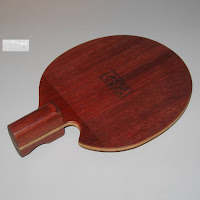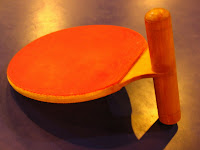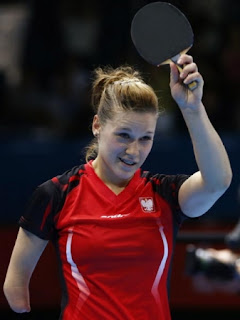Why the old kind of glue was banned
The old glue was banned because it contained VOC, volatile substances, that can be bad for both nature and humans. What damage that this old kind of table tennis glue has actually done is not clear, but supposedly it could harm mucous membranes when breathing it in, and even cause cancer if you're exposed to high amounts. But the suspicions towards the glue has existed for a long time, and in tournaments players haven't been allowed to perform gluing inside the venue, so the risks have probably been extremely low even for active players unless they've regularly stuck their nose in their glue cans.
The unhealthy substances also usually go away after 2-3 days, so this old kind of glue can still be used by manufacturers when they make pre-assembled rackets - simply because the problem is gone before the product is even sold. And those rackets would probably pass a glue test performed by a referee. There is not really any point in trying to exploit this fact though, since the booster effect disappears within a matter of hours.
How Speed Glue Works
The speed glue does two things. The first is expanding the sponge rubber, which makes it stretch the chemically unaffected top layer rubber which therefore gets more elastic. The second is making the sponge softer, which makes the ball come as close to the wood as possible during hard hits. (That's why hard hits produce more of a woody "click" noise when using tuner - and that's why the whole thing is also called "click effect".) This means that your choice of blade will matter more than usually if you're an offensive player. Unless you use Chinese rubbers, which most of the time have a hard sponge rubber that won't be noticeably affected by booster. If you're a defensive player, speed glue might not do you any good at all. Then even glue sheets can be enough.
How VOC glue was used, varied a little bit. Some people chose to only use the speed glue, since it did stick the rubbers to the blade. Some chose to let the speed glue get into the rubber before applying regular glue. Some simply just mixed the two kinds into one can. Some practically drowned the sponge rubbers so they wouldn't stick to the blade without prolonged pressure. Some put on a sufficient amount of glue and waved the racket towards the rubber so they would both look dry within a minute or two and stick immediately. In the end, most methods probably led to the same result.
After the ITTF had banned glue that contained VOC and glue that affected the rubbers' properties, the manufacturers developed a new, water-based, glue - and suddenly some things had changed.
Water-Based Glue - Applied differently
The old glue is thin, and applied with a brush. The rubber should be attached to the blade when the glue has dried enough to not look glossy anymore, and most of the time the rubber sticks and can be used immediately.
The new glue, on the other hand, is thick and applied with a sponge to even it out (because a brush will make thick trails which can cause bumps in the rubber). The rubber should be attached to the blade when the glue has turned from white to transparent, and then be put in pressure for about half an hour before you can be sure it stays on the blade.
The opinions about the application differs all over the web. Some say it doesn't matter much whether you use a brush or a sponge, while others say using a brush can ruin the rubbers permanently. I also read somewhere that water-based glue can ruin rubbers that have already been used with booster, by expanding both the rubber layers and cause permanent "bubbles".
Slow application and no improving any properties, - are there any advantages...?
Advantages with Water-Based Glue
Earlier, many people re-glued with tuner just for the fun of it, even if they didn't need it. Much money has been wasted on it, and now that's over. Instead, the manufacturers develop rubbers that already have the wanted properties when you buy them, and maybe that will lead to a funnier game for the same price in the future.
Another advantage is the possibility to remove the glue itself. The picture to the right shows a used racket that I recently bought. Since I'm mainly a collector nowadays, I always remove the rubbers shortly after I get a racket so they won't collect dust. This time I didn't even have to use acetone, because the rubbers just slid right off (even though they were attached strongly enough for play). Then I could easily peel all of the rubber away - from both blade and rubber - with my fingers in 5-10 minutes. Great for collectors who want to try their old blades without affecting the wood! A little different from the VOC glue, which sank into the blade, and that you might remove from the rubbers with gasoline...
Tell about your experience with water-based glue!
If you've used the new kind of glue, and would like to share your experiences, please write a comment below! If you know any differences between different manufacturers' glue, please be specific!
How VOC glue was used, varied a little bit. Some people chose to only use the speed glue, since it did stick the rubbers to the blade. Some chose to let the speed glue get into the rubber before applying regular glue. Some simply just mixed the two kinds into one can. Some practically drowned the sponge rubbers so they wouldn't stick to the blade without prolonged pressure. Some put on a sufficient amount of glue and waved the racket towards the rubber so they would both look dry within a minute or two and stick immediately. In the end, most methods probably led to the same result.
After the ITTF had banned glue that contained VOC and glue that affected the rubbers' properties, the manufacturers developed a new, water-based, glue - and suddenly some things had changed.
Water-Based Glue - Applied differently
The old glue is thin, and applied with a brush. The rubber should be attached to the blade when the glue has dried enough to not look glossy anymore, and most of the time the rubber sticks and can be used immediately.
The new glue, on the other hand, is thick and applied with a sponge to even it out (because a brush will make thick trails which can cause bumps in the rubber). The rubber should be attached to the blade when the glue has turned from white to transparent, and then be put in pressure for about half an hour before you can be sure it stays on the blade.
The opinions about the application differs all over the web. Some say it doesn't matter much whether you use a brush or a sponge, while others say using a brush can ruin the rubbers permanently. I also read somewhere that water-based glue can ruin rubbers that have already been used with booster, by expanding both the rubber layers and cause permanent "bubbles".
Slow application and no improving any properties, - are there any advantages...?
Advantages with Water-Based Glue
Earlier, many people re-glued with tuner just for the fun of it, even if they didn't need it. Much money has been wasted on it, and now that's over. Instead, the manufacturers develop rubbers that already have the wanted properties when you buy them, and maybe that will lead to a funnier game for the same price in the future.
 |
| Water-based glue on rubber and blade |
Tell about your experience with water-based glue!
If you've used the new kind of glue, and would like to share your experiences, please write a comment below! If you know any differences between different manufacturers' glue, please be specific!













